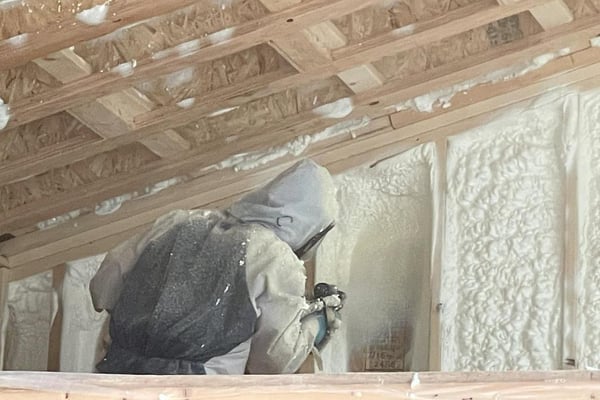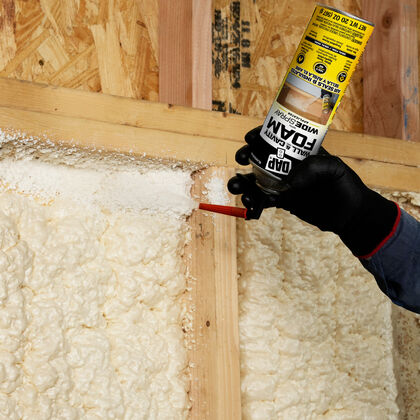Spray Foam: The Ultimate Option for Air Sealing and Insulation
Spray foam insulation has actually arised as a leading solution for effective air sealing and thermal insulation, providing an one-of-a-kind combination of residential properties that establish it apart from conventional approaches. Comprehending the complete scope of its advantages, installation procedures, and contrasts with various other insulation types is vital for making notified choices.
What Is Spray Foam?
Spray foam is a versatile insulation product that integrates the principles of air securing and thermal resistance to boost energy effectiveness in buildings. Made up mainly of polyurethane or other comparable compounds, spray foam is used as a fluid that expands upon call with surfaces, creating a strong, continuous layer of insulation. This unique residential or commercial property allows it to fill up gaps, splits, and spaces that traditional insulation products may ignore, offering a superior air seal.
There are 2 main kinds of spray foam: open-cell and closed-cell. Open-cell spray foam is lighter and much more adaptable, providing superb noise absorption and a reduced R-value per inch - Spray Foam. In contrast, closed-cell spray foam is denser, giving a higher R-value, dampness resistance, and added architectural honesty to developing parts
The application process normally involves specific equipment, guaranteeing a smooth application that sticks to numerous substrates, consisting of concrete, metal, and timber. This adaptability makes spray foam appropriate for both brand-new buildings and retrofitting existing frameworks. Its capacity to create a closed barrier substantially adds to decreasing power intake and improving indoor air high quality, therefore making it a preferred choice amongst property owners and building contractors alike.
Benefits of Spray Foam Insulation
Among the most considerable advantages of spray foam insulation is its extraordinary ability to develop a continuous air barrier, which efficiently lessens power loss. Unlike standard insulation products, spray foam broadens to fill up fractures and spaces, making sure that air leak is drastically reduced. This particular not just boosts power effectiveness however likewise results in lower utility costs with time.
In addition, spray foam insulation gives remarkable thermal resistance, adding to a much more stable interior setting. Its high R-value per inch enables efficient insulation in confined spaces, making it excellent for attic rooms, wall surfaces, and crawl areas. The moisture-resistant residential or commercial properties of spray foam help protect against mold and mold growth, promoting much healthier living conditions.
An additional important benefit of spray foam insulation is its sound-dampening qualities (Spray Foam). It successfully decreases noise transmission in between rooms, developing a quieter and much more comfy home atmosphere. The resilience of spray foam additionally stands apart, as it does not droop or clear up over time, preserving its performance throughout its life expectancy
How Spray Foam Works
Recognizing how spray foam insulation functions is essential for valuing its effectiveness in air sealing and thermal resistance. Spray foam insulation contains two main components: isocyanate and polyol resin. When these parts are mixed, they go through a chemical reaction that triggers the product to expand quickly, developing a dense foam that fills up fractures, tooth cavities, and voids.
As the foam broadens, it sticks to surface areas, forming a closed seal that substantially lowers air infiltration. This characteristic makes spray foam insulation extremely efficient at protecting against drafts and moisture penetration, which can result in energy loss and damage gradually. In addition, the closed-cell version of spray foam offers superior thermal resistance due to its rigid structure, efficiently lessening warm address transfer.
The special properties of spray foam allow it to comply with irregular surfaces, ensuring comprehensive coverage and a smooth obstacle. As an outcome, spray foam insulation not just improves energy efficiency but also adds to boosted interior air high quality by decreasing the accumulation of allergens and pollutants. Eventually, comprehending the mechanics behind spray foam underscores its duty as a premium option for insulation and air sealing in both business and domestic applications.
Setup Process Introduction

Prior to installment, the space should be adequately cleaned up and prepped, making certain that surfaces are without dampness, dirt, and particles. This action is critical because contaminants can jeopardize bond and total efficiency. When the location is prepared, the application includes blending both parts of the spray foam, check my source which increases upon call and loads voids effectively.
Trained professionals should conduct the installation, utilizing specialized equipment to ensure uniform coverage and optimal thickness. Safety and security preventative measures, consisting of putting on safety gear and guaranteeing appropriate ventilation, are vital during this process. After application, the foam typically cures promptly, creating a strong barrier that enhances power performance.
Contrasting Spray Foam to Standard Insulation
When evaluating insulation alternatives, spray foam insulation stands out in comparison to traditional products such as fiberglass and cellulose. Unlike fiberglass and cellulose, which can allow air seepage, spray foam expands upon application, loading gaps and holes to produce an airtight seal.
Furthermore, spray foam offers a greater R-value per inch than standard insulation types, using more efficient thermal resistance in a thinner profile. This characteristic is particularly helpful in spaces with minimal cavity deepness. Spray foam is resistant to dampness and mold development, which can be a significant worry with cellulose and fiberglass, specifically in humid atmospheres.
Nonetheless, spray foam insulation generally brings a greater upfront expense than its standard equivalents. Homeowners need to consider this first investment against long-lasting power financial savings and efficiency advantages. Ultimately, while both insulation types serve their function, spray foam arises as an advanced option for modern insulation needs, particularly in terms of air sealing and thermal performance.

Final Thought
In recap, spray foam insulation represents a very effective option for achieving optimal air securing and thermal resistance. Its special residential or commercial properties, including moisture resistance and sound dampening, make it suitable for various applications in both brand-new building and constructions and retrofitting tasks (Spray Foam). The preliminary costs might be higher contrasted to standard insulation materials, the long-term advantages, such as significant power cost savings and improved interior air high quality, warrant the financial investment and underscore its worth in modern structure methods.
Spray foam insulation has arised as a leading solution for reliable air sealing and thermal insulation, supplying a special combination of buildings that set it apart from typical techniques.Spray foam is a versatile insulation material that incorporates the principles of air securing and thermal resistance to enhance power efficiency in buildings.When evaluating insulation choices, spray foam insulation stands out in contrast to conventional products their website such as fiberglass and cellulose. Ultimately, while both insulation types offer their purpose, spray foam arises as an extra advanced option for modern insulation requirements, specifically in terms of air sealing and thermal effectiveness.
In recap, spray foam insulation stands for a highly efficient remedy for accomplishing ideal air securing and thermal resistance.